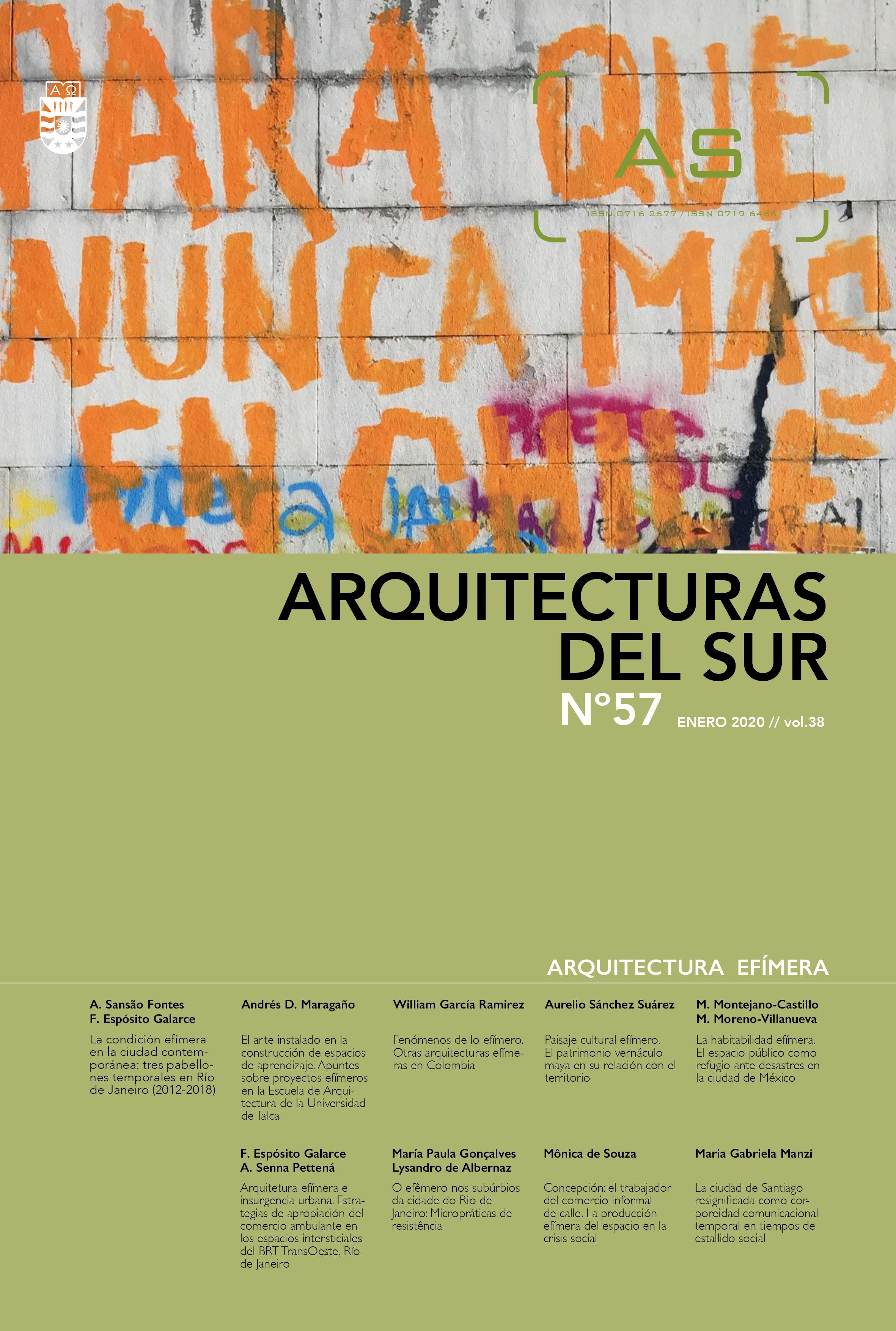Ephemeral habitability: Public space as a refuge from disasters in Mexico City
DOI:
https://doi.org/10.22320/07196466.2020.38.057.05Keywords:
public space, disasters, urban management, ephemeral architecture, construction for emergenciesAbstract
In the collective imaginary, the concept of habitability has been conceived mainly as a fixed and permanent feature of a built space. However, in cities with disaster risks, certain emerging conditions have required that spaces -in principle undeveloped- should suddenly become habitable spaces in their broadest sense, such as the use of public spaces as a shelter during emergencies and disaster recovery. This condition has given rise, spontaneously or in a planned way, to the construction of an ephemeral habitability in the public space. However, in the road to achieve that condition, there are many diverse factors ranging from actions to prevent the disappearance of public spaces due to privatization, to a good coordination of programs to achieve that habitability. This article analyzes as many of those factors as possible, based on an analysis of strengths, opportunities and threats for the case of Mexico City. The results indicate that in the face of a constant threat of privatization of public space, the habitability of these spaces has been promoted through programs and different instruments, but in a scattered way and without continuity over time. On the other hand, despite the weaknesses and threats detected, strengths and opportunities are identified that can serve as a basis for formulating strategies to make public spaces more habitable during a post-disaster situation, for one of that country’s highest populated disaster exposed cities.
Downloads
References
Allan, P., Bryant, M., Wirsching, C., García, D. & Rodríguez, M.T. (2013). The influence of Urban Morphology on the Resilience of Cities Following an Earthquake. Journal of Urban Design, 18(2), 242-262.
Anhorn, J. & Khazai, B. (2015). Open space suitability for emergency shelter after an earthquake. Natural Hazards and Earth System Sciences, (15), 789–803.
Asuad Sanén N. E. (2010). La desindustrialización relativa de la ciudad de México de 1980-2003. En XX Seminario de Economía urbana y regional; Junio 23, México, D.F.: Instituto de Investigaciones Económicas de la UNAM.
Berroeta, H., Carvalho, L. & Masso, A. (2016). Significados del espacio público en contextos de transformación por desastres socionaturales. INVI (31), 143-170.
Bryant, M. & Allan, P. (2013). Open Space Innovation in earthquake Affected Cities. In: Tiefenbacher, J. (2013), Approaches to Disaster Management – Examining the Implications of Hazards, Emergencies and Disasters, (pp. 183-2014), Intech.
Gándara, G., Leal, A. R. y Palomino, C. (2014). Matriz FODA y matriz IGO. En G. Gándara y F. J. Osorio Vera, coord. (2014), Métodos Prospectivos. Manual para el estudio y la construcción del futuro (pp. 323-338). México: Paidós.
Gobierno del Distrito Federal (2000). Bando número 2. 2000.
Lofland, L. (1985). A World of Strangers: Order and Action un Urban Public Space, San Francisco: University of California Press, p. 19, en Delgado, M. (2011), El espacio público como ideología. Madrid: Editorial Catarata, p. 17-18.
Mafi Ezatollah, Roshani, P., Hassani, A. & Hossien, S. A. (2012). Analyzing of Reduction Process of Urban Open Spaces in Process of Cities Development with Emphasis on Crisis Management in Theran Metropolis. International Journal of Applied Science and Technology, 2(7), 302-313.
Magadán M. & López Morales, F. (1987). El sismo de 1985 en México: destrucción y reconstrucción. Buenos Aires, Argentina: Boletín de Medio Ambiente y Urbanización; Comisión de Desarrollo Urbano y Regional, CLACSO, pp. 15-22.
Meli R. (2002). El sismo de 1985 en México. En: Lugo Hubp J.e Inbar M. (eds). Desastres naturales en América Latina. (pp. 125-146), México, D.F.: Fondo de Cultura Económica.
Monsiváis, C. (2012). “No sin nosotros”. Los días del terremoto 1985-2005. México: Ediciones Era, p. 72.
Montejano Castillo, M. & Moreno Villanueva, M. (2016). The adaptability of public space in Mexico City after an earthquake: a preliminary classification. International Journal of Safety & Security Engineering, 6(2), 104-113.
¿Qué pasó ahi?...La nostalagia del Parque del Seguro Social” (17 de octubre de 2014). Excelsior, Recuperado de http://www.excelsior.com.mx/comunidad/2014/10/17/987353 (Accessado: 15 Augosto 2015).
SEGOB / Banco Mundial (2012). El Fondo de Desastres Naturales de México-Una Reseña. Banco Internacional de Reconstrucción y Fomento / Banco Mundial. Recuperado de http://www.proteccioncivil.gob.mx/work/models/ProteccionCivil/Almacen/fonden_resumen_ejecutivo.pdf
Turer Baskaya, F.A. (2015). Disaster sensitive landscape planning for the coastal megacity of Istanbul. Journal of Coastal Conservation, (19), 729-742.
Villagra, P., Rojas, C., Ohno, R., Xue, M. & Gómez, K. (2014). A GIS-base exploration of the relationships between open space systems and urban form for the adaptive capacity of cities after an earthquake: The cases of two Chilean cities. Applied Geography. (48), 64–78.
Webb, G. R. (2007). The Popular Culture of Disaster: Exploring a New Dimension of Disaster Research. In: Rodríguez, H., Quarantelli, E. L. & Russell D. (eds), Handbook of Disaster Research (pp. 430-440), New York: Springer.
Zhao, L., Li, H., Sun, Y., Huang, R., Hu, Q., Wang, J. & Gao, F. (2017). Planning Emergency Shelters for Urban Disaster Resilience: An Integrated Location-Allocation Modeling Approach. Sustainability (9), 1-20.
Downloads
Published
How to Cite
Issue
Section
License
The content of the articles published in each issue of Arquitecturas del Sur is the sole responsibility of the authors and does not necessarily represent the opinion of University of the Bío-Bío.
The authors will maintain their copyright; however, they will guarantee the journal the right to first publication and dissemination of their work. The publication of the article in Arquitecturas del Sur will be subject to the Creative Commons International license (CC BY-SA) that allows others to adapt: remix, transform and build on the material for any purpose, even commercially; share: copy and redistribute the material in any medium or format, as long as the authorship and first publication in this journal are acknowledged by citing them correctly, and their new contributions are under a license with the same terms.














 Programa de Información Científica/Concurso Fondos de Publicación de Revistas Científicas 2018/ Proyecto Mejoramiento de Visibilidad de Revistas UBB (Código:FP180007)
Programa de Información Científica/Concurso Fondos de Publicación de Revistas Científicas 2018/ Proyecto Mejoramiento de Visibilidad de Revistas UBB (Código:FP180007) 
